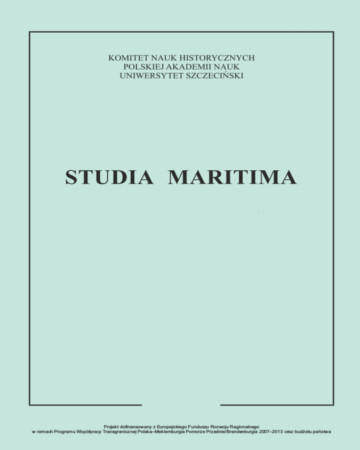






| Authors: |
Bolesław
Hajduk
Uniwersytet Szczeciński, Instytut Historii i Stosunków Międzynarodowych |
| Keywords: | economic relations between Scandinavia and Poland competition and cooperation in the mutual relations the interwar period of the 20th century |
| Data publikacji całości: | 2015 |
| Page range: | 36 (89-124) |
| 1. | Bolewski A., Związki wytwórczości mineralnej z polskimi portami morskimi, Gdańsk 1947. |
| 2. | Czerwińska W., Polska żegluga morska w latach II Rzeczypospolitej, Gdańsk 1971. |
| 3. | Czerwińska W., Rola państwa w polskiej gospodarce morskiej 1919–1939, Gdańsk 1975. |
| 4. | Dehmel H., Gdynia–Ameryka Linie Żeglugowe S.A. 1930–1950, Gdańsk 1969. |
| 5. | Demidow M., Eksport polskiego węgla do Danii w okresie międzywojennym, „Studia i Materiały do Dziejów Śląska” 1971, t. 11. |
| 6. | Denkiewicz-Szczepaniak E., Działalność dyplomatyczna i gospodarcza Samuela Eyde’go w Polsce w latach 1919–1923, [w]: Polska – Norwegia 1905–2005, red. J. Szymański, Gdańsk 2006. |
| 7. | Hajduk B., Polsko-duńskie kontakty portowe i żeglugowe w latach 1919–1939, „Komunikaty Instytutu Bałtyckiego” 1979, z. 30. |
| 8. | Hajduk B., Kontakty polsko-duńskie w dziedzinie przemysłu okrętowego i rybołówstwa w latach 1919–1939, „Komunikaty Instytutu Bałtyckiego” 1980, z. 31/32. |
| 9. | Hajduk B., Z problematyki porozumień handlowych pomiędzy Polską i Danią w latach 1934–1939, „Komunikaty Instytutu Bałtyckiego” 1981, z. 33. |
| 10. | Hajduk B., Polski system celny w latach 1919–1924, „Roczniki Dziejów Społecznych i Gospodarczych” 1992/1995, t. 53–55, Poznań 1995. |
| 11. | Hajduk B., Polskie migracje zarobkowe do Skandynawii w latach 1892–1940, „Rocznik Gdański” 1997, t. 57, z. 2. |
| 12. | Hajduk B., Gospodarka Gdańska w latach 1920–1945, Gdańsk 1998. |
| 13. | Hajduk B., Skandynawowie w życiu gospodarczym Wolnego Miasta Gdańska, [w:] Polska – Szwecja 1919–1999, red. J. Szymański, Gdańsk 2000. |
| 14. | Hajduk B., Działalność spółki duńskiej Højgaard & Schultz AS w Polsce w latach 1924–1949, [w:] Polska – Dania w ciągu wieków, red. J. Szymański, Gdańsk 2004. |
| 15. | Hajduk B., Z działalności Skandynawów w międzywojennej Gdyni (1922–1939), [w:] Miscellanea pomorskie. Studia z dziejów Pomorza Zachodniego i Nadwiślańskiego, red. W. Skóra, Słupsk 2008. |
| 16. | Hajduk B., Z problematyki stosunków handlowych między Polską i Islandią w latach 1919–1939, [w:] Tantum possumus quantum scimus. Księga pamiątkowa |
| 17. | dedykowana Profesorowi Z. Chmielewskiemu w siedemdziesiątą rocznicę urodzin, red. R. Gaziński, A. Makowski, Szczecin 2012. |
| 18. | Højgaard & Schultz AS, Ingeniører og Entreprenører 1918–1943, Købehavn 1943. |
| 19. | Hołowiński J., Polsko-Skandynawskie Towarzystwo Transportowe „Polskarob” w latach 1927–1939, [w:] Materiały do 40-lecia Polski na morzu 1920–1960, z. 1, Gdańsk 1960. |
| 20. | Jałowiecki A., Konkurencja węglowa polsko-brytyjska na rynkach skandynawskich, Toruń 1935. |
| 21. | Kawczyński J., Import owoców południowych do Polski, Gdynia grudzień 1938 [ze zbiorów prof. S. Waschko, w posiadaniu B. Hajduka]. |
| 22. | Landau Z., Tomaszewski J., Gospodarka Polski międzywojennej, t. 3: (1930–1935), Warszawa 1982. |
| 23. | Matla A., Zarys polsko-norweskich kontaktów gospodarczych w latach 1918–1921, „Komunikaty Instytutu Bałtyckiego” 1983, z. 35. |
| 24. | Matla A., Polsko-norweskie kontakty żeglugowe w latach 1919–1926, „Komunikaty Instytutu Bałtyckiego” 1986/1987, z. 38/39. |
| 25. | Matla A., Organizacja zbytu norweskich śledzi na rynku polskim w latach 1919–1939, „Komunikaty Instytutu Bałtyckiego” 1988/1991, z. 40. |
| 26. | Matla A., Działalność norweskiego koncernu Bergenske w portach polskiego obszaru celnego w latach 1919–1939, „Komunikaty Instytutu Bałtyckiego” 1992, z. 41. |
| 27. | Mielczarek R., Budowa portu handlowego w Gdyni w latach 1924–1939, Gdańsk 2001. |
| 28. | Pullat R., Stosunki polsko-fińskie w okresie międzywojennym, tłum. M. Galińska, Warszawa 1998. |
| 29. | Steyer D., Półwiecze Polski na morzu, Gdańsk 1970. |
| 30. | Stosunki dyplomatyczne Polski. Informator, t. 1: Europa 1918–2006, red. K. Szczepanik, A. Herman-Łukasik, B. Janicka, Warszawa 2007. |
| 31. | Szymański J., Stosunki gospodarcze Polski ze Szwecją w latach 1919–1939, Gdańsk 1978. |
| 32. | Szymański J., Kapitał norweski wobec gospodarki Polski międzywojennej (1919–1939), „Zapiski Historyczne” 1987, z. 2. |
| 33. | Szymański J., Polsko-skandynawska współpraca w zakresie żeglugi w okresie międzywojennym (1919–1939), Gdańsk 1988. |
| 34. | Szymański J., Stosunki gospodarcze Polski z Norwegią w latach 1918–1929, Gdańsk 2005. |
| 35. | Uggla A.N., Rola Alfa de Pomiana Haydukiewicza w grze o wizerunek Polski w Szwecji po pierwszej wojnie światowej, [w:] Polska – Szwecja 1919–1999, red. J. Szymański, Gdańsk 2000. |
| 36. | Waschko S., Zboże i mąka (referat), 1935 [w posiadaniu B. Hajduka]. |
| 37. | Waschko S., Systemy celne, Warszawa 1971. |
| 38. | Widernik M., Porty Gdańska i Gdyni w życiu gospodarczym II Rzeczypospolitej, Gdańsk 1991. |